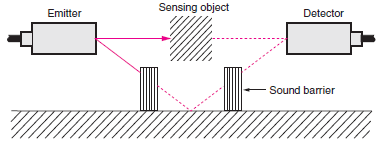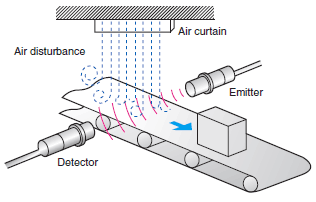Ultrasonic Sensors
|
|
|
|
| Safety Precautions |
For precautions on individual products, refer to Safety Precautions in individual product information.

These Sensors cannot be used in safety devices for presses or other safety devices used to protect human life. These Sensors are designed for use in applications for sensing workpieces and workers that do not affect safety.

Precautions for Safe Use
Wiring
Power supply voltage
Do not use a voltage in excess of the operation voltage range.
Appying a voltage in excess of the operation voltage range, or applying AC power (100 V AC or greater) to a DC power model sensor may result in explosion or fire.
Load short-circuiting
Do not short-circuit the load. Explosion or fire may result.
Incorrect wiring
Do not reverse the power supply polarity or otherwise wire incorrectly.
Explosion or fire may result.
Connection without a load
If the power supply is connected directly without a load, the internal elements may explode or burn. Be sure to insert a load when connecting the power supply.
Operating Environment
Do not use in an environment where there are explosive combustible gases.
Precautions for Correct Use
Mounting
Sensor mounting angle
In the case of level control or distance control, the stability of the detection signal is affected by the condition of the reflection surface of the detected object.
Mount the sensor so that the ultrasound beam is perpendicular to the reflection surface.
Obstacles around the sensor
Take care that incorrect operation does not occur due to spreading of the ultrasound beam or stray reflection caused by the side lobe.
Through-beam model sensor can be affected by reflection from the floor. In this event, lay a cloth, sponge, or other sound absorbent material on the floor, or install a sound-proof wall.

Installation
When installing the sensor unit, secure it using the provided mounting nuts or the unit mounting holes. (For details, see the dimensions diagram.)
When mounting an ultrasound sensor, do not tap it with a hammer as this will damage water resistance.
If the unit is not sufficiently secured, vibration may damage the unit and shifting may prevent correct detection.
Ambient atmosphere
To maintain operational reliability and prolong product life, do not use at temperatures in excess of the rated temperature, and do not use outdoors.
The ultrasound sensor uses air as the transmission medium. Local temperature differences may cause reflection and refraction at the boundary and air flow may cause the detection area to change, which will result in incorrect operation. Avoid using the sensor in locations with an air curtain blower or other similar machine.

Do not use near any kind of air nozzle, as the jet sound produced by the nozzle contains multiple frequency components and will affect ultrasound detection.
Water drops on the sensor surface (Emitter and Detector) will decrease the detection distance.
Detection is not possible of sound absorbent materials such as cotton and powder. (Reflective models)
At low temperatures (0°C or less), the vinyl cable will harden and the wires may break if the cable is bent. Do not bend a Standard or Robot Cable at low temperature.
Wiring
Bending the Cable
If you need to bend the cable, we recommend a bend radius that is at least 3 times the outer diameter of the cable. (For coaxial, shielded and robot cables, at least 5 times the outer diameter of the cable is recommended.)
The minimum bending radius is specified as the radius of the inside surface of the cable bend.

Cable Tensile Strength
When wiring the cable, do not subject the cable to a tension greater than that indicated in the following table.
| Cable diameter | Tensile strength |
| Less than 4 mm | 30 N max. |
| 4 mm or greater | 50 N max. |
Note:Do not subject a shielded cable or coaxial cable to tension.
Separation from High Voltage (Wiring Method)
Do not lay the cables for the Sensor together with high-voltage lines or power lines. Placing them in the same conduit or duct may cause damage or malfunction due to induction interference. As a general rule, wire the Sensor in a separate system, use an independent metal conduit, or use shielded cable.

Others
When using a commercially available switching regulator, ground FG (the frame ground terminal) and G (the ground terminal).


